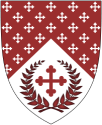Living in the Current Middle Ages Part 2
HERALDRY
Since the dawn of time, man has striven to distinguish himself from his fellow man. This was accomplished by deed, signs, symbols and badges, and by appearance. Around the beginning of the 12th century, the shield, probably because it was a convenient flat surface, was painted with the owner’s design. This personal identification, the Arms, spread to the banner and lance pennon, to the horses’ trappings, and to the rider’s surcoat, hence the name Coat of Arms. Heraldry developed with remarkable rapidity, perhaps due to practical necessities of the Crusades. After all, an armored knight with a closed visor would be indistinguishable from another.
In the Society, armorial bearings are personally selected by the lord or lady who is to wear them. A number of factors might influence their design. A pun on a name or a reference to a town or other locale. Perhaps an animal renown for its strength, courage or ferocity is chosen. Perhaps it’s an object which represents your craft or trade. A great majority of arms have no discernible meaning. The likelihood is that a coat of arms was devised for the best of all heraldic reasons: to distinguish its bearer, at a distance or in the fog of war, from all others. No matter what the choice, your design will add color and atmosphere and shall be uniquely yours.
At first glance, heraldic terminology may appear difficult and incomprehensible. Mastering a few rules will soon have you proficient and versed. A Herald’s description of a coat-of-arms is called a blazon. The arms are distinguished by certain colors, metals, and furs and are collectively known as the tinctures. The tincture of the field, or surface of the shield, is the first item in the blazon. The are five (5) colors (red, blue, green, purple, and black) and two (2) metals (silver/white & gold/yellow).
In addition, there are Ordinaries and Charges. An ordinary helps divide the field. Several examples include the Pale, Chevron, Bend or Fess. A charge is an animal or object, real or fictitious, which is portrayed in the design. Examples would include a castle, gauntlet, dragon, tree, horse or lion. Nearly all arms include either an ordinary or a charge, and many have both. As space here is limited, representations of ordinaries and charges are not permissible. Additional information concerning Heraldry can be obtained through your Herald. He/she can assist you with ideas or suggestions and can answer any questions you may have. In addition, they will have the necessary forms necessary to register your device with the Society.
SCA COMBAT
SCA Combat is probably one of the most visible aspects of the Society. It is commonly referred to as simply "fighting". This activity attracts much attention and many new members have joined the SCA after having seen a demonstration of this period martial art.
Participation in SCA fighting is open to anyone who has reached the age of 18. It should be mentioned that men and women both actively participate in this activity.
Should you decide to pursue Society combat, your local Marshal can provide you with information concerning armor regulations, the rules of combat, as well as, answer any questions you may have concerning Society fighting.
Before one is allowed to enter his/her first list, a fighter must be "authorized" (qualified). He/she must be sufficiently skilled so that they are not a danger to themselves or others. In addition, the fighter will be expected to know the "Rules of the List" prior to fighting in any Tournament or War. Again, your local Marshal can assist in explaining the steps necessary to become authorized. Such procedures are established to reduce the risk of injury to any/all participants.
No SCA fighting is staged or choreographed. All fights are "live"; the outcome of a list or battle is never pre-determined. The champion of an engagement is decided when one opponent acknowledges that the blow landed by his opponent was of sufficient force to have caused death. Each fighter is on "his/her honor" to determine whether or not a hit is considered a killing blow. The Marshals do not act as referees nor do they decide a match. They are present to merely enforce the safety regulations.
Two types of fighting "styles" exist in Atlantia: Heavy Armored Combat and Rapier Combat. The former usually involves metal or leather armor, wooden shields and rattan swords. The latter is sometimes referred to "Light Weapons Fighting" and uses modified fencing equipment to simulate fighting techniques of the Renaissance period. If you're interested in either style of SCA combat, contact your Knight Marshal or Rapier Marshal for additional information, equipment requirements and regulations.
RECOMMENDED READING
There are a number of publications available through the Office of the Stock Clerk. New members may wish to purchase a copy of The Known World Handbook which contains numerous articles on various aspects of the Society and Society life. The Compleat Anachronist series contain information pertaining to a particular subject or field of study. For a complete listing contact the Stock Clerk; their address is listed below (under Membership).
In addition, a paid membership will provide you with monthly issues of the kingdom newsletter, The Acorn (in Atlantia). This periodical contains event listings and other current information. In addition, you will receive quarterly issues of Tournaments Illuminated.
MEMBERSHIP
Membership provides a discount on site fees and is required for holding some offices. See the SCA membership website for details on membership typs and costs:

